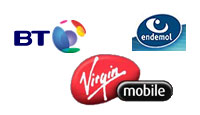 They’ve been busy boys at BT this week, with the UK telecoms giant making two major announcements.
They’ve been busy boys at BT this week, with the UK telecoms giant making two major announcements.
On Monday, BT announced a content partnership with Big Brother producer Endemol to provide original shows and interactive content for BT’s new broadband television service.
Endemol now join a growing list of broadband content providers signed up by BT whose roster now includes recently bagged deals with BBC Worldwide, Paramount, Warner Music, National Geographic, HIT Entertainment and Nelvana.
BT/Virgin mobile TV deal
With the ink still drying on the Endemol deal, BT have also announced a new agreement with Virgin Mobile to offer TV services through its broadcast digital TV and radio service, BT Movio.
Virgin Mobile – Britain’s fourth-largest mobile operator – will use BT’s Movio mobile TV product to give their customers access to a wide range of digital TV content and more than 350 DAB digital radio stations.
 Using the UK’s existing digital audio broadcasting (DAB) network, the broadcast service will be offered on a limited exclusive basis to virgin Mobile customers later this year. BT Movio will be available in the future to all mobile operators in the UK.
Using the UK’s existing digital audio broadcasting (DAB) network, the broadcast service will be offered on a limited exclusive basis to virgin Mobile customers later this year. BT Movio will be available in the future to all mobile operators in the UK.
The announcement of the deal coincided with the unveiling of HTC’s new handset at the 3GSM World Congress 2006.
HTC Trilogy handset
The Trilogy TV handset, the world’s first DAB-IP enabled Smartphone, was developed jointly by BT, TTP and HTC and sports a 2.2″ screen for viewing video content and multimedia-focused features including a removable storage and an integrated 1.3 mega pixel camera.
Emma Lloyd, managing director, BT Movio said: “Bringing the world’s first DAB-IP enabled Smartphone to market is another huge achievement for BT and the beginning of a step change towards open standards in the area of TV broadcasting over DAB.”
“By working with Microsoft and HTC we have been able to develop a handset that provides an easy to view, high quality experience, wrapped into a hi-spec media driven mobile phone. This will be vital in attracting mobile operators to the BT Movio service,” she added.
 Microsoft partnership
Microsoft partnership
BT has developed a strategic relationship with Microsoft for delivering broadcast services on a mobile handset, with their Windows Media technologies enabling BT Movio to deliver high-quality audio and video content over a DAB network using minimal bandwidth.
The BT Movio service also comes with Windows Media Digital Rights Management (DRM) technology for the secure delivery of premium video and music content.
These are certainly interesting times for BT, with their recent activity seeing the company pushing ahead to create an alternative distribution network and channel for existing content to both broadband and mobile devices.
Although Orange, 3, and the Vodafone Group already offer streamed TV channels over their 3G mobile networks, this solution gobbles up precious bandwidth.
Phones on the BT Movio service, on the other hand, simply pick up broadcasted signals. As Virgin’s sales and marketing director Graeme Hutchinson explains: “It’s not downloaded; it’s not looped; it’s real TV just like you get at home.”
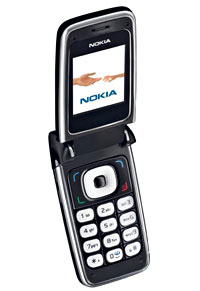 Launched at the 3GSM World Congress in Barcelona, Nokia’s new 6136 phone is being touted as the handset that brings GSM and wireless LANs together.
Launched at the 3GSM World Congress in Barcelona, Nokia’s new 6136 phone is being touted as the handset that brings GSM and wireless LANs together.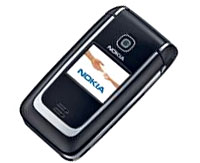 The quad-band Nokia 6136 will be able to connect to GSM networks at 850, 900, 1800, and 1900MHz (so no problems using it in the States as well as Europe) and comes with a built in 1.3 megapixel camera and FM radio.
The quad-band Nokia 6136 will be able to connect to GSM networks at 850, 900, 1800, and 1900MHz (so no problems using it in the States as well as Europe) and comes with a built in 1.3 megapixel camera and FM radio.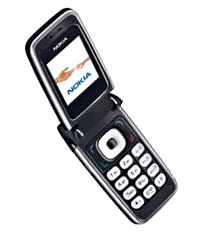 At a press conference on Monday, Jorma Ollila, Nokia’s chief executive said, “We want to help our customers complement their existing mobile services with mobile IP. UMA gives users an alternative to PC-based VoIP,”
At a press conference on Monday, Jorma Ollila, Nokia’s chief executive said, “We want to help our customers complement their existing mobile services with mobile IP. UMA gives users an alternative to PC-based VoIP,” Anyone who’s anyone in the 3GSM world will be hot footing it to the 3GSM World Congress in Barcelona, which starts tomorrow.
Anyone who’s anyone in the 3GSM world will be hot footing it to the 3GSM World Congress in Barcelona, which starts tomorrow. The mobile phone industry is desperate to come up with mass market services to entice consumers to use 3G networks, but they’ve got their work cut out, with a recent survey finding that almost 80 per cent of UK users said that mobile services are getting too complicated.
The mobile phone industry is desperate to come up with mass market services to entice consumers to use 3G networks, but they’ve got their work cut out, with a recent survey finding that almost 80 per cent of UK users said that mobile services are getting too complicated. BT are also going to be at the show and are expected to launch their new broadcast digital TV to mobile service,
BT are also going to be at the show and are expected to launch their new broadcast digital TV to mobile service, 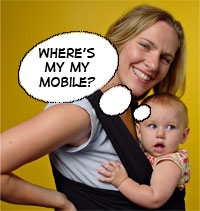 According to a new report, future growth in the Japanese mobile market is to be focused on the only market segment yet to reach 100% saturation: the under 14s and over 55s.
According to a new report, future growth in the Japanese mobile market is to be focused on the only market segment yet to reach 100% saturation: the under 14s and over 55s.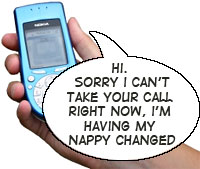 The biggest growth, however, comes from the 55-65 age group, with 1.62 million new customers expected in 2006.
The biggest growth, however, comes from the 55-65 age group, with 1.62 million new customers expected in 2006.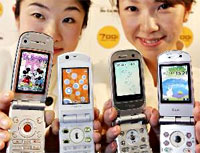 Blended ARPU is expected to continue sliding from $58 pcm in 2005 to $57 pcm by 2007 but this should be compensated by data ARPU which is predicted to rise from $15 pcm to $17 pcm over the same period, thanks to the growth of content market.
Blended ARPU is expected to continue sliding from $58 pcm in 2005 to $57 pcm by 2007 but this should be compensated by data ARPU which is predicted to rise from $15 pcm to $17 pcm over the same period, thanks to the growth of content market. T-Mobile was told to see the headmaster and returned with a derrier rouge after making exaggerated claims about its “web’n’walk” mobile Internet service.In a wave of PR-driven hyperbole
T-Mobile was told to see the headmaster and returned with a derrier rouge after making exaggerated claims about its “web’n’walk” mobile Internet service.In a wave of PR-driven hyperbole 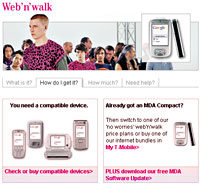 T-Mobile had a valiant stab at a defence, arguing that their advert was all about making the distinction between Ye Olde Crappe WAP and their new, full Internet-access, web’n’walk service, adding that they had included the line, “subject to coverage”.
T-Mobile had a valiant stab at a defence, arguing that their advert was all about making the distinction between Ye Olde Crappe WAP and their new, full Internet-access, web’n’walk service, adding that they had included the line, “subject to coverage”. To the sound of a salvo of slapped wrists, the statement concluded that the ad, “was misleading because readers were likely to interpret the claim to refer to geographical network coverage. We told T-Mobile to avoid making such unconditional claims in future advertising.”
To the sound of a salvo of slapped wrists, the statement concluded that the ad, “was misleading because readers were likely to interpret the claim to refer to geographical network coverage. We told T-Mobile to avoid making such unconditional claims in future advertising.”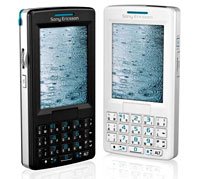 Sony Ericsson have announced their new M600 handset, a tri-band (900/1800/1900 plus UMTS 2100 for 3G data outside the US) jobbie, with Symbian OS 9.1 and UIQ 3.0 operating systems.
Sony Ericsson have announced their new M600 handset, a tri-band (900/1800/1900 plus UMTS 2100 for 3G data outside the US) jobbie, with Symbian OS 9.1 and UIQ 3.0 operating systems.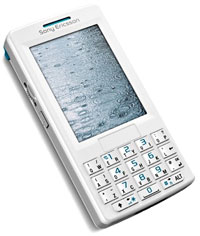 Touted as a “fully-specified email tool and mobile phone”, the handset offers true multitasking, so a user can, for example, browse the Internet while chatting away on the phone.
Touted as a “fully-specified email tool and mobile phone”, the handset offers true multitasking, so a user can, for example, browse the Internet while chatting away on the phone.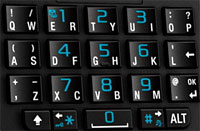 For road warriors and shuffling suits, there’s the facility to read and edit PowerPoint, Word and Excel documents and Adobe PDF files on the move, with the popular Opera 8 browser provided for surfing the Internet.
For road warriors and shuffling suits, there’s the facility to read and edit PowerPoint, Word and Excel documents and Adobe PDF files on the move, with the popular Opera 8 browser provided for surfing the Internet.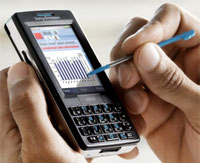 In line with its business focus, there’s no built in camera, and Wi-Fi is an unfortunate omission too.
In line with its business focus, there’s no built in camera, and Wi-Fi is an unfortunate omission too.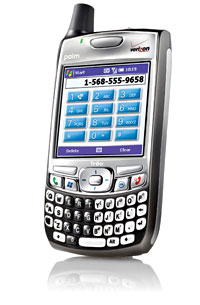 It’s been spluttering and wheezing in its sick bed for what seems like an eternity, but the latest figures from research firm IDC confirm that the prognosis isn’t good for the Personal Digital Assistant (PDA).
It’s been spluttering and wheezing in its sick bed for what seems like an eternity, but the latest figures from research firm IDC confirm that the prognosis isn’t good for the Personal Digital Assistant (PDA).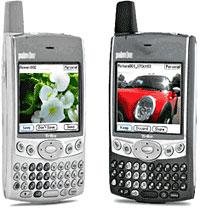 Although a bright Christmas period saw sales grow 37.6% over Q3, the trend remains resolutely downward, with the declining market segment driving PDAs into a market niche.
Although a bright Christmas period saw sales grow 37.6% over Q3, the trend remains resolutely downward, with the declining market segment driving PDAs into a market niche.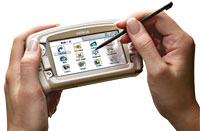 But don’t go ordering flowers for the PDA funeral quite yet, as IDC research analyst Ramon Llamas insists that it’s not all over for the PDA market, with plenty of smaller vendors remaining committed to a more niche PDA market.
But don’t go ordering flowers for the PDA funeral quite yet, as IDC research analyst Ramon Llamas insists that it’s not all over for the PDA market, with plenty of smaller vendors remaining committed to a more niche PDA market.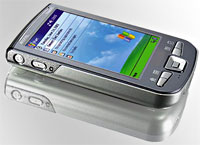 With Palm winding down its PDA business and concentrating on its Treo smartphone range, Nelson argues that Palm will have difficulty competing against deep-pocketed rivals like Dell and HP who are currently ploughing big R&D budgets into similar products.
With Palm winding down its PDA business and concentrating on its Treo smartphone range, Nelson argues that Palm will have difficulty competing against deep-pocketed rivals like Dell and HP who are currently ploughing big R&D budgets into similar products.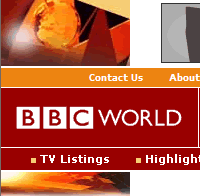 BBC World have been busy bunnies of late, signing distribution deals all over the globe.
BBC World have been busy bunnies of late, signing distribution deals all over the globe. The video streams include the adverts that would be shown if BBC World were being shown on the TV in the region. As yet, BBC World aren’t charging their advertisers any extra to splash them on mobile screens – they’re seeing it as added value for them
The video streams include the adverts that would be shown if BBC World were being shown on the TV in the region. As yet, BBC World aren’t charging their advertisers any extra to splash them on mobile screens – they’re seeing it as added value for them In the 3/Hutchinson Australia deal, the subscribers are being asked to pay Au$4/month for unlimited access, Au$2/day or Au$0.50/two minutes.
In the 3/Hutchinson Australia deal, the subscribers are being asked to pay Au$4/month for unlimited access, Au$2/day or Au$0.50/two minutes.